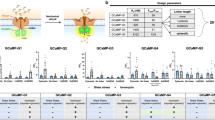Abstract
We have developed a reusable piezoelectric sensor that enables rapid characterization of cell viability and response to cell-affecting agents. This is accomplished via a novel polymer transduction principle that involves reaction of a pH-sensitive amphoteric polymer with metabolically generated acid. Subsequent adhesion of the protonated polymer to the transducer surface causes a decrease in the sensor resonant frequency corresponding to the cell metabolic rate. This disclosure provides the first example of a piezoelectric sensor capable of detecting metabolic responses of viable cells. The sensor provides real-time measurement of cell metabolism and division rates, and antibiotic sensitivity. This technology provides the basis for an advanced piezoelectric sensor that does not require immobilized biological receptors and can be miniaturized without compromising signal-to-noise factors.
This is a preview of subscription content, access via your institution
Access options
Subscribe to this journal
Receive 12 print issues and online access
$209.00 per year
only $17.42 per issue
Buy this article
- Purchase on Springer Link
- Instant access to full article PDF
Prices may be subject to local taxes which are calculated during checkout
Similar content being viewed by others
References
Habermehl, K.O. 1985. Rapid Methods and Automation in Microbiology and Immunology, Springer-Verlag, Berlin.
Hattori, T. 1988. The Viable Count: Quantitative and Environmental Aspects, Brock-Springer, Madison.
McCormick, D. 1986. Detection technology: The key to environmental biotechnology. Bio/Technology 4: 419–422.
Nelson, W.H. 1985. Instrumental Methods for Rapid Microbiological Analysis, VCH, Wienheim.
Karube, I. 1987. Analytical device and method for analysis of biochemicals, microbes and cells. European Patent Application No. 86307115.5.
Ward, M.D. and Buttry, D.A. 1990. In-situ interfacial mass detection with piezoelectric transducers: Fundamentals and applications. Science In press
Sauerbrey, G. 1959. Verwendung von Schwingquarzen zur Wagung dunner Schichten und zur Mikrowagung. Z. Phys. 155: 206–222.
Parce, J.W., Owicki, J.C., Kercso, K.M., Sigal, G.B., Wada, H.G., Muir, V.C., Bousse, L.J., Ross, K.L., Sikic, B.J. and McConnell, H.M. 1989. Detection of cell-affecting agents with a silicon biosensor. Science 246: 243–247.
Foss, R.P. 1988. Acrylic amphoteric polymers. U.S. Patent 4,749,762.
Ingraham, J.L. 1987. Escherichia Coli and Salmonella Typhimurium Cellular and Molecular Biology. Neidhardt, F. C., Ingraham, J. L., Brooks, K., Magasanik, M., Schaechter, M., and Umbarger, H. E. (Eds.). American Society for Microbiology, Washington, D.C.
Gottschalk, G. 1987. Bacterial Metabolism, Verlag-Springer, New York.
Lasky, S.J. and Buttry, D.A. 1989. Sensors based on biomolecules immobilized on the piezoelectric quartz crystal microbalance . Chemical Sensors and Microinstrumentation 403: 237–251.
Muramatsu, H., Tamiya, E. and Karube, I. 1989. Detection of odorants using lipid-coated piezoelectric crystal resonators. Anal. Chim. Acta 225: 399–408.
Ballantine, D.S., Jr. Rose, S.L., Grate, J.W., and Wohltjen, H. 1986. Correlation of surface acoustic wave device coating responses with solubility properties and chemical structure using pattern recognition. Anal. Chem. 58: 3058–3066.
Carey, W.P., Beebe, K.R., Kowalski, B.R., Illman, D.L. and Hirsh-feld, T. 1986. Selection of adsorbates for chemical sensor arrays by pattern recognition. Anal. Chem. 58: 149–153.
Ema, K., Yokoyama, M., Nakamoto, T. and Moriizumi, T. 1989. Odour-sensing system using a quartz-resonator sensor array and neural-network pattern recognition. Sensors and Actuators 18: 291–296.
Wenzel, S.W. and White, R.M. 1988. A multisensor employing an ultrasonic Lamb-wave oscillator. IEEE Trans. Elect. Dev. 35: 735–743.
Ricco, A.J., Martin, S.J., Niemczyk, T.M. and Frye, G.C. 1989. Liquid-phase sensors based on acoustic plate mode devices. Chemical Sensors and Microinstrumentation 403: 191–207.
Ward, M.D. 1988. Investigation of open circuit reactions of polymer films using the quartz crystal microbalance. Reactions of polyvinylfer-rocene films. J. Phys. Chem. 92: 2049–2054.
Author information
Authors and Affiliations
Rights and permissions
About this article
Cite this article
Ebersole, R., Foss, R. & Ward, M. Piezoelectric Cell Growth Sensor. Nat Biotechnol 9, 450–454 (1991). https://doi.org/10.1038/nbt0591-450
Received:
Accepted:
Issue Date:
DOI: https://doi.org/10.1038/nbt0591-450



